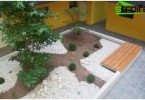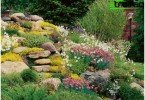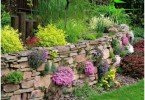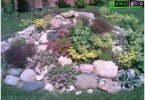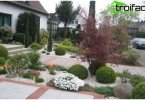Flower Design Tips
Floral arrangements, acting as an element of garden decoration, can create an atmosphere of comfort in a suburban area. Variegated flower beds, delighting the eye with lush flowering and exuding a marvelous aroma, cheer up the owners of the site and their guests. Thinking over the design of flower beds, each gardener tries to create plant compositions that will not only harmoniously combine with the general style atmosphere, but also effectively distinguish the garden from the others.
Content
- Flower design
- Choosing a place, designing a flower garden and creating a frame
- Flowerbed filling
Flower design
The design of the flowerbed is a real art, because when compiling the compositions of the plant, it should be selected not only taking into account the aesthetic attractiveness, but also their growing characteristics.
Masters of landscape design when designing flower beds use small tricks, thanks to which plant compositions delight with a riot of color, starting from the first spring days and right up to frosts.
When planning the design of a flower garden in the country, you need to consider some nuances:
- Harmonious combination of flowers and decorative foliage.
When choosing plants for group planting, it is advisable to give preference not only to flowering, but also to decorative leafy varieties, paying attention to their size and shape. Plants with decorative foliage will serve as an excellent backdrop for colorful flowers and fill the voids in the flowerbed formed during periods of calm between lush flowering. Do not be afraid to experiment, combining dense foliage with openwork.
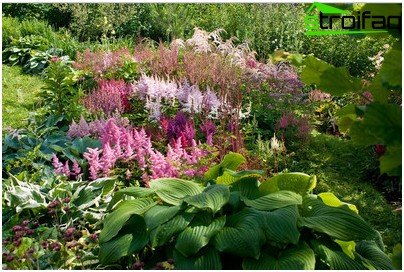
A combination of the beautiful hosta decorated with large powerful leaves, with a delicate and refined astilbe looks originally
- Create a complete composition.
Regardless of whether it is a flower garden arranged along the path in the garden or a fragrant flower bed decorating the front area of the plot, the plant composition should have a complete look. An effective design technique for flowerbeds and flower beds is to complement the composition with ground cover and undersized varieties. The soil protectors planted along the outer contour of the flower bed will visually create a smooth transition from a colorful flower “oasis” to lawn grass or a path. Perfect for framing a flower garden: dwarf varieties of spirea, stunted geraniums, medunitsa and heichera.
- Flowers – soloists of the ensemble.
When compiling flower beds, it should be remembered that the greatest decorative effect gives only a harmonious combination of plants. In any composition there are soloists that attract attention and strike with amazing beauty and splendor of flowering, but there are plants that act as a backdrop for them. Complementing a friend, they form a single pictorial picture.
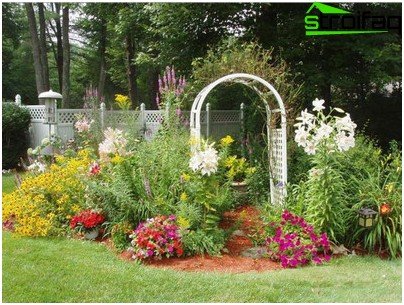
For example, in this photo of a flower garden design, the role of soloists is performed by beautiful lilies, daylilies and rudbeckia act as a background for them, and petunias play a living frame
- Selection of annuals and perennials.
When decorating the flower beds, perennials should be used. They can grow in one place for several years..
Among the beautiful varieties of perennials that do not require a lot of care, one can single out: daylilies, Volzhanka, hosts, Rogersia, hellebore and peonies. When compiling the composition, do not forget about annuals.
Passing the entire vegetation cycle in just one season, and decorating the composition with bright colors of the most bizarre shapes and colors, annual flowers make the flowerbed more festive and elegant.
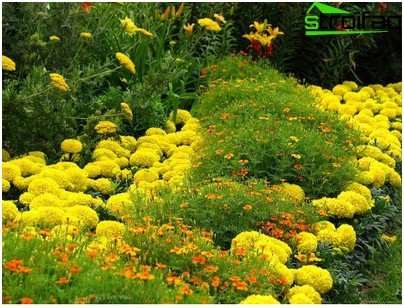
The main stages of making and designing a flower garden with your own hands
Choosing a place, designing a flower garden and creating a frame
When deciding to decorate your site with a beautiful plant composition, first of all, you need to decide on a place for its arrangement. Although most flowering varieties can tolerate minor shading, they show the greatest beauty only in sunny areas.
Choosing a place for arranging a flower garden, you need to think about its shape and size. For beginning gardeners, it’s better to get started with training, making small flower beds filled with only two to three varieties of plants. So it’s much easier to choose the right color combination of neighboring plants when planting and their subsequent care.
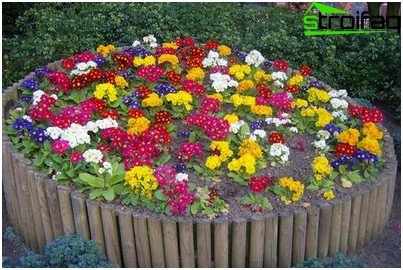
For example, an elegant spring flowerbed can be created from several varieties of primroses having different shapes and shades of flowers
Traditionally, small flower beds are given a square or round shape: they look attractive from any viewing angle, it is convenient to look after them, removing weeds and overgrown perennials. But herbal compositions can have a variety of curly shapes. It all depends on the flight of the wizard’s imagination and the size of the site. For clarity, you can pre-draw a scheme of the flower garden, designating multi-colored circles as the location of the main plants.
For marking and determining the boundaries of the flower garden, you can use pegs with a stretched rope. Having decided on the borders of the flowerbed, you need to provide a fence.
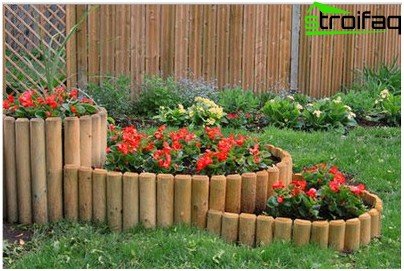
The low fence around the flower bed will not only make the composition look complete and neat, but also prevent flowers from growing beyond its borders.
A decorative fence can be made of logs 25-35 cm high, wood cuts mounted on a rib, or wattle can be equipped with tree branches 1-2 cm thick.
Flowerbed filling
Before planting, the soil in the flower bed needs to be dug up and fertilized if necessary. For these purposes, you can use both organic and mineral fertilizers. Flower plantings are formed taking into account the height of the plants and their flowering period..
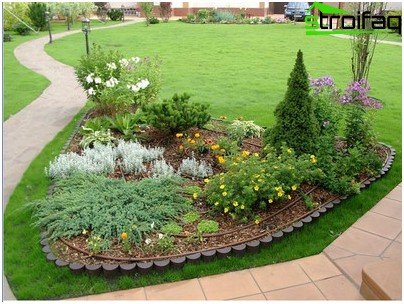
When arranging a flowerbed, which can be viewed from anywhere in the plot, multilevel flower plantings are used
In the foreground, low-growing and ground cover plants are placed, the middle tier is filled with plants 40-80 cm high, and tall tapeworms are planted in the center. If the flower bed is placed along the wall, then the highest varieties of flowers are planted not in the center of the composition, but in the background.
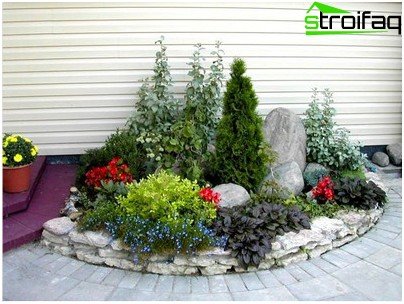
The carefully thought-out design of the flower beds and flower beds of the photo allows you to make the site unsurpassed and unique in its kind.
There are many design options for flower beds: it can be miniature “live” compositions on old tree stumps, a cascade of flower beds made of concrete multi-level stands.
Do not be upset if the created composition does not immediately have the desired visual effect. You can always correct the situation with the help of portable flower beds. Seasonal flowers, containers landed, will be a bright addition to any flower bed.


